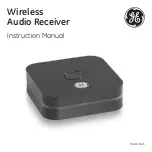
21
IR IN
AC OUTLETS
AC 120V 60Hz
SWITCHED
TOTAL 120W 1A MAX.
AC
INLET
AM
ANT.
FM
ANT.
75
MULTI
CHANNEL
INPUT
RS
232
GND
C
AMP
IN
R
L
MAIN
ZONE 2
DIGITAL
OUTPUT
(COAXIAL)
AC-3
RF
DIGITAL
INPUT
(COAXIAL)
DIGITAL
OUTPUT
(OPTICAL)
DIGITAL
INPUT
(OPTICAL)
INPUT 2
P
B
P
R
Y
INPUT 3
P
B
P
R
Y
OUTPUT
P
B
P
R
Y
COMPONENT
VIDEO
INPUT 1
P
B
P
R
Y
C D
I N
I N
I N
I N
OUT
OUT
L
R
PHONO
TAPE
2
TAPE
1
DVD
VIDEO
5
VIDEO
4
VIDEO
3
ZONE 2
VIDEO
1
VIDEO
2
L
VIDEO
S VIDEO
R
MONITOR
OUT
OUT
OUT
IN
IN
IN
IN
IN
IN
OUT
1
2
VIDEO
S VIDEO
R
L
3
2
1
3
2
5
4
1
BACK
L
L
R
BACK
R
SURROUND (SURR)
SPEAKERS
R
L
FRONT
SPEAKERS
CENTER
SPEAKER
FRONT
SURR
BACK
SURR
PRE OUT
SUB
WOOFER
1
2
A
B
12 V TRIGGER
( 6 OHMS MIN. )
( 6 OHMS MIN. )
MODEL NO.
DTR-9.1
AV RECEIVER
+
–
+
–
+
–
+
–
+
–
+
–
+
–
Connecting speakers
Connecting a subwoofer
Use the PRE OUT SUBWOOFER jack to connect a
subwoofer with a built-in power amplifier. If your
subwoofer does not have a built-in amplifier, connect
an amplifier to the PRE OUT SUBWOOFER jack and the
subwoofer to the amplifier. The output to PRE OUT
SUBWOOFER 1 and PRE OUT SUBWOOFER 2 is the same.
Surround
left
speaker
Surround
back left
speaker
Surround
back right
speaker
Surround
right
speaker
Front left
speaker
Front right
speaker
Center
speaker
Subwoofer
5/8"
1
3
4
5
2
NO!
NO!
+ – – +
+ – – +
R
L
R
L
Connecting speakers
Notes:
• The DTR-9.1 is designed to produce optimum sound
quality when speakers with impedances within the
specified ranges are connected. Check the follow-
ing information and choose speakers with appropri-
ate impedances for the connections.
CAUTION:
SPEAKER IMPEDANCE
6 min. per each speaker terminal.
• When you are using only
one speaker or when you
wish to listen to monaural
(mono) sound, a single
speaker should never be
connected in parallel to
both the right and left-
channel terminals simul-
taneously.
• To prevent damage to
circuitry, never short-cir-
cuit the positive (+) and
negative (–) speaker wire.
Connecting the speaker cable
1. Strip away 5/8" of wire insulation.
2. Twist wire ends very tight.
3. Unscrew
4. Insert wire
5. Screw
















































